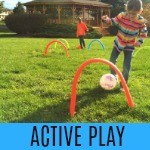In today’s digital age, it’s more important than ever to encourage kids to connect with nature. Spending time with your kids outdoors fosters a sense of wonder and curiosity about the world. Additionally, creating a backyard nature area is a wonderful way to inspire kids to engage with the natural environment right at home. In this blog post, we’ll share practical tips and ideas to help you transform your backyard into a captivating space where kids can discover, learn, and also appreciate the beauty of nature.

Here are 10 practical tips for creating a backyard nature area:
1. Choose the Perfect Location
First, selecting the right spot for your backyard nature exploration area is crucial. Look for an area that receives a mix of sunlight and shade throughout the day. Also, consider the proximity to trees, plants, or a water source if possible. This will create a diverse ecosystem for exploration and observation.
2. Incorporate Native Plants
Next, introduce native plants to your backyard to attract local wildlife and create a more authentic natural environment. Start by researching the native plants in your region and choose a variety that will attract butterflies, birds, and insects. Planting wildflowers, shrubs, and trees not only adds beauty to the area but also provides food and shelter for the local fauna.
3. Construct a Fairy Garden or Miniature Nature Habitat
Bring a touch of magic to your backyard by creating a fairy garden or miniature nature habitat. Designate a small area where children can build a tiny world using rocks, twigs, pebbles, and other natural materials. Next, add miniature plants, a small pond or stream, and even tiny furniture or decorations. Not only does this activity allows children to exercise their creativity and develop storytelling skills. But it also fosters learning about the importance of creating habitats for small creatures like fairies, insects, or woodland animals.
4. Build a Bug Hotel or Insect Habitat
Constructing a bug hotel is a fun and educational project that invites insects into your backyard. Gather natural materials like logs, twigs, pinecones, and leaves to create nooks and crannies for bugs to shelter and hibernate. Kids can observe different insects up close and learn about their habits, life cycles, and roles in the ecosystem.
5. Install Bird Feeders and Birdhouses
Hang bird feeders and install birdhouses to attract a variety of feathered friends to your backyard. Encourage kids to identify different bird species, learn their calls, and observe their behavior. Provide a range of bird feeders with different types of seeds to cater to the specific preferences of various bird species in your area. Similarly, you can make your own birdfeeders using recyclables or put together a make-a-birdfeeder kit!
6. Set up a Nature Exploration Table
Designate a specific area with a nature exploration table to display findings from outdoor adventures. For example, include magnifying glasses, binoculars, field guides, and sketchbooks. This space encourages children to examine and document their discoveries, fostering their observation skills and nurturing a sense of curiosity.
7. Create Sensory Stations
Incorporate sensory stations in your nature exploration area to engage children’s senses and enhance their connection to the natural world. For instance, set up areas for smelling flowers or herbs, touching different textures of leaves or rocks, and listening to the sounds of birds or wind chimes. These stations promote mindfulness and sensory awareness.
8. Provide Tools for Exploration
Equip your kids with exploration tools such as bug catchers, butterfly nets, and shovels. These tools enable hands-on learning experiences and help children understand the delicate balance of ecosystems. Teach them about respecting and handling creatures gently before releasing them back into their habitats.
9. Encourage Nature-inspired Art
Encourage artistic expression by providing art supplies in your nature exploration area. For example, set up an outdoor easel or a designated art corner where children can create nature-inspired artwork, such as leaf rubbings, bark rubbings, or paintings of flowers and animals. This activity fosters creativity while deepening their appreciation for the natural world. Here’s a handy guide to getting started painting en plein air with kids.
10. Create Space for Unstructured Play
Finally, be sure to provide ample space for unstructured play in your backyard nature exploration area. Allow children to engage in imaginative play, build forts using fallen branches, or create their own nature-inspired games. Unstructured play encourages problem-solving, social skills, and a sense of adventure.
More Backyard Fun for Kids
- How to Create a Wildlife Friendly Backyard
- 5 Tips for Exploring Nature with Kids
- Nature Packs for Kids
- Insect Lab Nature Investigation
- Check out more Nature Activities for Kids from our friends at Fireflies and Mud Pies
By creating a backyard nature exploration area, you provide an enriching environment where children can connect with nature, cultivate curiosity, and develop a deep appreciation for the natural world. Through hands-on experiences, observation, and creative activities, your kids will foster a lifelong love for nature while developing important skills. Have fun!








